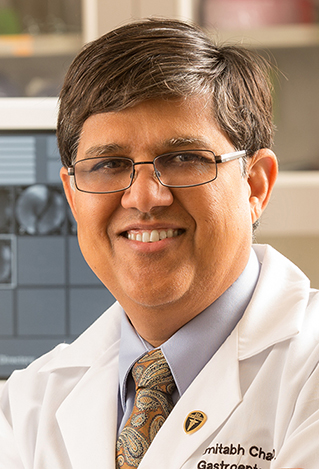Advancing Detection of Barretts Esophagus
January 15, 2018
New screening procedures promise early detection without endoscopy
UH Digestive Health Institute - Winter 2018
 Amitabh Chak, MD
Amitabh Chak, MDBarrett's esophagus is a known risk factor for esophageal cancer, yet it remains undiagnosed in many patients. Advances in early detection aim to change that.
Barrett's esophagus is considered a serious complication of gastroesophageal reflux disease (GERD). About 10 percent of people with GERD develop the condition, in which the tissue that lines the esophagus changes to resemble the lining of the intestine in response to damage cause by the acid exposure.
Because it has no specific symptoms, many people with Barrett's esophagus don't know they have it.
“Most doctors just treat the heartburn, so we don't detect most Barrett's cases,” says Amitabh Chak, MD, Gastroenterologist, UH Digestive Health Institute, UH Cleveland Medical Center and Professor of Medicine, Case Western Reserve University School of Medicine.
DEVELOPING A NEW TESTING METHOD
The standard method to check for GERD – and related conditions such as Barrett's esophagus – is with an upper gastrointestinal endoscopy and biopsy. Because the risk of developing Barrett's and esophageal cancer is relatively low, most patients don’t receive an upper endoscopy. For patients who don’t have serious GERD symptoms, upper endoscopy is simply a costly and generally unnecessary procedure.
However, for patients who do have Barrett's esophagus, a missed diagnosis could mean a missed opportunity to treat precancerous cells, or dysplasia, before they advance to esophageal cancer. Esophageal cancer has a poor overall survival rate of less than 15 percent. Early detection can save lives.
With grant funding from Barrett's Esophagus Translational Research Network (BETRNet), Dr. Chak and a team of researchers recently completed the first clinical trial for a new non-endoscopic Barrett's esophagus screening method.
“We wanted to develop an easier, less expensive alternative than endoscopy to test for this condition,” Dr. Chak says. “Most people with Barrett's present with advanced cancer, so we don't get a chance to prevent it.”
The clinical trial uses an inflatable balloon that patients swallow via a capsule attached to a thin tube. When a doctor inflates the balloon, it brushes against the esophageal walls to collect samples. Clinicians can then test the samples for Barrett's esophagus – ideally, before cells develop into dysplasia or esophageal cancer.
“We're focusing on developing genetic markers to not only help diagnose Barrett's, but also determine which cases may progress to cancer,” Dr. Chak explains. He says UH plans to launch a second trial for the balloon method soon.
Dr. Chak is also working on a Barrett's esophagus patient registry — one of the only familial Barrett's registries in the country — to help improve detection and treatment options. “I discovered that Barrett's runs in families,” he says. “We discovered one gene mutation that we published on last year. We're working on identifying other genes involved.”
NEW TREATMENTS
If patients are found to have Barrett’s esophagus with dysplasia or cancer, the University Hospitals Digestive Health Institute’s Esophageal & Swallowing Center offers advanced treatment options for all types and stages of esophageal cancer.
The most common treatment for dysplasia is radiofrequency ablation, Dr. Chak says. Radiofrequency ablation uses radio waves to kill precancerous and cancerous cells in the Barrett’s tissue. An electrode mounted on a balloon or endoscope creates heat to destroy the abnormal cells.
“Radiofrequency ablation isn't a standalone treatment,” he notes. “We often combine it with other endoscopic therapies that either cut or freeze the Barrett's tissue away. We're currently involved in research to improve cryotherapy techniques.”
REMEMBERING THE RISKS
Although about 20 percent of the American population suffer from GERD, only a small percentage of these patients develop Barrett's esophagus. And only a small percentage of Barrett's cases progress to cancer. But even one case of cancer is one too many.
Patients with two or more of the following risk factors should be screened for Barrett's esophagus:
- Being a white male over age 50
- Having chronic GERD that doesn't get better when taking proton pump inhibitors
- Being overweight
- A hiatal hernia
- A history of current or past smoking.
Meanwhile, the UH Digestive Health Institute’s ongoing work to develop noninvasive screening processes will help prevent esophageal cancer in more patients. “This is a disease that needs to be tackled – and we're on the forefront,” Dr. Chak says.
To refer a patient for evaluation of GERD or Barrett’s esophagus, call 216-844-8500. To learn more about clinical trials and other research programs for Barrett’s esophagus, contact Wendy Brock, RN, at 216-844-3273.


